Meet the brachiosaurus, the giraffe dinosaur
Dinosaurs are fascinating animals for most people. Perhaps this is due to the fact that we do not know everything about them, have not lived at the same time, have brought a riddle that needs to be solved, among other things. This turns out to be exciting and has made more people like these extinct animals millions of years ago.
There are some very famous species, such as tyrannosaurus rex, pterodactyl, triceratops, among others. However, there are others that are not much explored and yet they are as fantastic as the most common ones. This is the case with brachiosaurus. And so, do you already know what dinosaur we're talking about? No ... Then find out with us!

Say hello to brachiosaurs
Brachiosaurus lived about 150.8 million years ago during the late Jurassic Period. Its name means "arm lizard" because of its greatest feature: they had their front limbs - that is, their arms - much larger than their hind limbs - understood as their feet.
Another thing that characterizes this type of dinosaur is its very long neck that makes it resemble a giraffe. Paleontologists believed for many years that this was the largest species of sauropod ever. Nowadays, however, there is evidence that other animals were much larger and heavier than him.
The first findings
Trying to find more fossils for his brontosaurus skeleton, paleontologist Othniel Marsh discovered in 1883 the first skull of a brachiosaurus in Colorado, United States. He knew that the found bone was not what he was looking for, but kept it so it could be studied and later classified.
In 1900, in the same region, Elmer Riggs found the first partial skeleton of a hitherto unknown species. He named him Brachiosaurus three years after his discovery. Then, in 1998, paleontologists associated Marsh's skull with the newly seen species. And that's how the studies about her began.
After that, many other remains of such a giraffe-like dinosaur were found in various locations, particularly in North America. Utah, Oklahoma, Wyoming, and Colorado are the states in which brachiosaurus fossils are most likely to be found.

Main characteristics of the species
As we said earlier, brachiosaurus had two striking features in its body. The first was the long front paws, much larger than the rear. Paleontologists believe they could not rise above the lower limbs - as was featured in the movie Jurassic Park.
In addition, his neck was gigantic, making him bear an incredible resemblance to the giraffe. Paleontologist Heinrich Mallison argued in an article published in "Sauropod Dinosaur Biology" that this species had much less energy than the others because of these characteristics.
Another very interesting thing about brachiosaurs is your body temperature. Researchers calculated in 2011, by measuring isotope indices, that these animals had about 45 ° C in their bodies. They were therefore classified as a warm-blooded animal as well as other sauropods.
Weight and height
The species is believed to be about 25 meters long, although it could be even larger, as the analyzed fossils came from sampling of animals that were not fully developed. The researchers then failed to reach an exact height of an adult brachiosaurus.
Much research has been done and, according to a study published in the journal PLOS Biology, in 2014, the animal of this species could weigh approximately 56 to 62 tons, taking into account the height and all the characteristics obtained so far on brachiosaurs. and your whole lifestyle.

How brachiosaurs lived
Some paleontologists believe that this dinosaur lived in water, mainly because of its nostril that was located at the top of its head. Others say that because of the air pockets found in their bodies, they would be quite unstable if they were deep water, and all of this generates much debate among experts.
A 2014 study published in the Journal of Theoretical Biology stated that brachiosaurs and other sauropods preferred flat land and needed to climb mountains and take long walks to consume energy, according to David Wilkinson, a biological scientist at Liverpool John Moores University in the United Kingdom. And this is what researchers have believed so far.
The feeding of these dinosaurs
Several studies and studies on the feeding of this dinosaur species have been done and one of them was published in 2008 in the Proceeding of the Royal Society B, showing that adult sauropods, including brachiosaurs, were mainly fed on coniferous trees, gingkoes and cycads. . That is, they were herbivores.
This same analysis concluded that these animals had to eat approximately 400 pounds of dry vegetation every day to have sufficient energy in their giant bodies. Its teeth were ideally shaped - in the form of a spoon - to remove the leaves without breaking large pieces of plants.

The life in society
Over time - and as the vegetation of a particular area became more scarce - brachiosaurs used to travel in groups to other areas where they could find abundant plants. So it turned out that these dinosaurs used to live in packs to defend themselves all the time.
Their sharp nails made the carnivorous dinosaurs keep some distance from the brachiosaurs. But they had time to get away: they spotted predators many miles away (thanks to their height) and fled, since they were not very fast, moving from 19 to 31 kilometers per hour.











